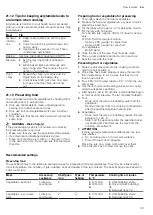
How it works
en
39
21.12 Tips for keeping acrylamide levels to
a minimum when cooking
Acrylamide is harmful to your health and is produced
when you cook cereal and potato products at very high
temperatures.
Meal
Tip
General
informa-
tion
¡
Keep cooking times as short as pos-
sible.
¡
Cook food until it is golden brown, but
not too dark.
¡
Use large, thick pieces of food. These
contain less acrylamide.
Baking
Set max. top/bottom heating to 200 °C.
Biscuits
¡
Set the max. top/bottom heating to
190 °C.
¡
Brush baked items and biscuits with
egg or egg yolk. This reduces the pro-
duction of acrylamide.
Oven
chips
¡
Spread the chips out evenly and in a
single layer on the baking tray.
¡
Cook at least 400 g at once on a bak-
ing tray so that the chips do not dry
out.
21.13 Preserving food
You can preserve fruit and vegetables by heating them
and sealing them in air-tight jars.
¡
Only use heat-resistant, clean, undamaged pre-
serving jars, rubber seals and clips.
¡
Only use fruit and vegetables which are in perfect
condition.
¡
Only use jars that are the same size and contain the
same food.
WARNING ‒ Risk of injury!
If the preserving process is not carried out correctly,
the preserving jars may crack.
▶
Make sure that you use the specified setting values.
▶
Use clean and undamaged preserving jars.
▶
Place no more than six ½ litre or 1 litre jars of food
in the oven at a time. Do not use jars that are larger
than this.
Preparing fruit or vegetables for preserving
1.
Thoroughly wash the fruit and vegetables.
2.
Prepare the fruit and vegetables, e.g. peel, remove
pips/stone and chop.
3.
Fill the glass up to approx. 2 cm below the mouth.
4.
Fill the jars with hot liquid.
For one-litre jars, approx. 400 ml of liquid is neces-
sary.
For fruit: Skimmed sugar solution
– Approx. 250 g sugar for sweet fruit
– Approx. 500 g sugar for sour fruit
For vegetables:
– Boiled water
5.
Wipe the rims of the jars. They must be clean.
6.
Place a damp rubber seal and a lid on each jar.
7.
Seal the jars with the clips.
Preserving fruit or vegetables
1.
Slide the universal pan into the cooking compart-
ment at shelf position 2.
2.
Once they have been prepared, place the jars into
the universal pan in such a way that they do not
touch one another.
3.
Pour 500 ml hot water (approx. 80 °C) into the uni-
versal pan.
4.
Use the recommended setting values when config-
uring the appliance settings.
a
After approx. 40 to 50 minutes, small bubbles begin
to form at short intervals. The jar contents "bubble".
5.
Fruit
‒
Once all of the jars are bubbling, switch off the
appliance.
‒
Remove the jars from the cooking compartment
after the specified residual heating time.
6.
Vegetables
‒
Once all of the jars are bubbling, reduce the tem-
perature to 120 °C.
‒
Switch off the appliance after the specified resid-
ual heating time and remove the jars from the
cooking compartment.
7. ATTENTION!
If there are large temperature differences, the jars
may shatter.
▶
Do not place jars on cold or wet surfaces.
▶
Protect the jars from draughts.
Place the jars on a clean cloth and cover them.
8.
Once the jars have cooled, remove the clips.
Recommended settings
Preserving food
The specified times in the table are average values for preserving fruit and vegetables. They may be influenced by
room temperature, the number of jars, quantity, heat and quality of the jar contents. The specifications are based on
1-litre round jars.
Meal
Accessory/
cookware
Shelf posi-
tion
Type of
heating
Temperature
in °C
Cooking time, minutes
Vegetables, beetroot:
1-litre pre-
serving jars
2
1.
170–180
2.
120–140
3.
-
1.
Until bubbling starts
2.
Once it starts bubbling:
35
3.
Residual heat: 30
Vegetables, e.g. cucum-
bers
1-litre pre-
serving jars
2
1.
170–180
2.
-
1.
Until bubbling starts
2.
Residual heat: 35














































